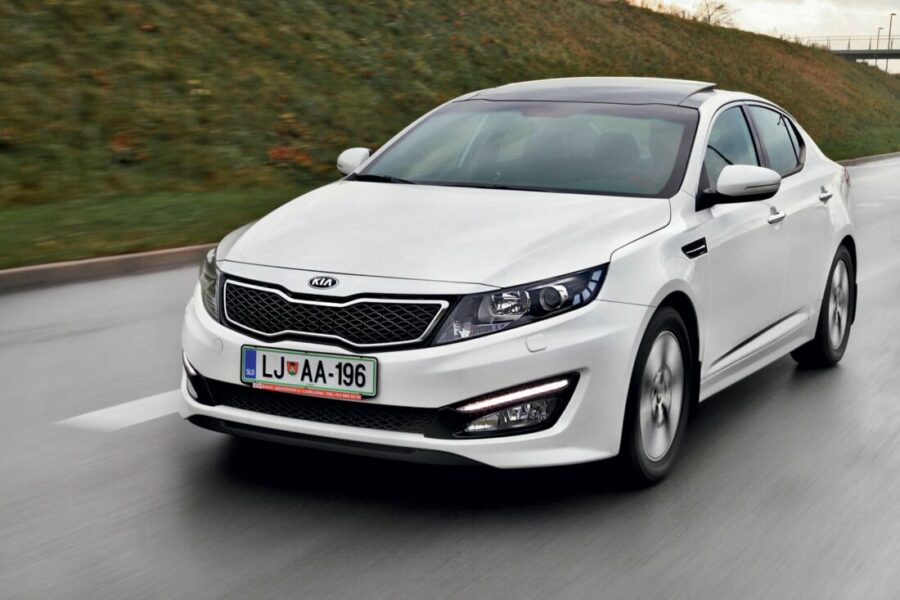
Short test: Kia Optima Hybrid 2.0 CVVT TX
A few years ago we looked at Korean cars from the outside, but today even strangers talk about Kia cars as traditional cars. It's true that Kia has followed the best recipe (for a customer!) And offered cars at a very reasonable price, but now that's what it is. There are a lot of their cars, even on Slovenian roads. The real euphoria in Slovenia was provoked by Cee'd and its sports version Pro_Cee'd. Otherwise, it is difficult to judge whether the car is successful and whether it is so simply for the price; but considering that it is also considered a vehicle for (adults) teenagers and slightly older women, it is not only cheap, but also convenient in design. After all, if this theory did not work, the lovely girls would drive Dacia. So don't ...
Step up or up, whatever you want, definitely the Kia Optima. It's a sleek and handsome sedan that can hardly be blamed. High-quality workmanship, above-average equipment and spacious interior; The car offers comfort and spaciousness to both the driver and passengers in the back seat. Obviously, the credit for this, even in the case of the Kia Optima, goes to chief designer Peter Schreyer, of whom Kia is very proud. He completely reinvented the brand in terms of design, and the models gained value and credibility through his ideas. Kia is aware of the status of the brand, so it does not impose a uniform design on all cars; otherwise there are visible similarities in design, but individual cars are quite independent in design. Also Optima.
But all good things come to an end. The Hybrid Optima, as nice, attractive and spacious as it is, doesn't seem like the best choice. The two-liter petrol engine boasts 150 "horsepower", but only 180 Nm; even if we add a good 46 "horsepower" and 205 Nm of constant torque from the electric motor and thus get a total power of 190 "horsepower" (which, of course, is not just the sum of both powers!), that is, more than a ton and a half heavy sedan takes its toll. Especially when it comes to gas mileage, where the CVT adds its own (negative) boiler.
The plant promises an average gas mileage that is 40 percent lower than the base petrol version, even at the diesel level. Among other things, the factory data write that Optima will consume from 5,3 to 5,7 l / 100 km in all driving modes. But the fact that this is impossible is already clear to the automobile ignoramuses; In fact, there is not a single car that can boast a difference of just 0,4 l / 100 km of gasoline used when driving in rural areas, on the highway or outside the village. And so does the Optima Hybrid.
During the test, we measured an average consumption of 9,2 l / 100 km, while accelerating and measuring as much as 13,5 l / 100 km, and this was a pleasant surprise when driving on a “normal circle” (moderate driving with all speed limits, without sudden movements ). acceleration and with a deliberate stop), where only 100 l / 5,5 km per 100 km were required. But at the same time, it is quite disturbing that the lithium-polymer battery (otherwise the new generation) with a capacity of 5,3 Ah was never charged more than halfway during the entire 14-day test. Of course, I have to be honest and write that we rode it in times of low temperatures. It's certainly a decent excuse, but it begs the question: does it make sense to buy a hybrid that doesn't work properly for several months of the year?
Text: Sebastian Plevnyak
Kia Optima Hybrid 2.0 CVVT TX
Basic data
| Sales: | KMAG dd |
|---|---|
| Base model price: | 32.990 € |
| Test model cost: | 33.390 € |
| Calculate the cost of auto insurance | |
| Acceleration (0-100 km / h): | 11,3 with |
| Maximum speed: | 192 km / h |
| Mixed flow ECE: | 9,2l / 100km |
Technical information
| engine: | 4-cylinder - 4-stroke - in-line - petrol - displacement 1.999 cm3 - maximum power 110 kW (150 hp) at 6.000 rpm - maximum torque 180 Nm at 5.000 rpm. Electric motor: permanent magnet synchronous motor - maximum power 30 kW (41 hp) at 1.400-6.000 - maximum torque 205 Nm at 0-1.400. Battery: Lithium Ion - nominal voltage 270 V. Complete system: 140 kW (190 hp) at 6.000. |
|---|---|
| Energy transfer: | engine-driven front wheels - continuously variable automatic transmission - tires 215/55 R 17 V (Bridgestone Blizzak LM-25V). |
| Capacity: | top speed 192 km/h - 0-100 km/h acceleration in 9,4 s - fuel consumption (combined) 5,4 l/100 km, CO2 emissions 125 g/km. |
| Mass: | empty vehicle 1.662 kg - permissible gross weight 2.050 kg. |
| External dimensions: | length 4.845 mm - width 1.830 mm - height 1.455 mm - wheelbase 2.795 mm - trunk 381 - fuel tank 65 l. |
Our measurements
| T = 13 ° C / p = 1.081 mbar / rel. vl. = 37% / Odometer Condition: 5.890 km | |
| Acceleration 0-100km: | 11,3s |
|---|---|
| 402m from the city: | 18,3 years ( 131 km / h) |
| Maximum speed: | 192km / h (D) |
| test consumption: | 9,2 l / 100km |
| Braking distance at 100 km / h: | 44,3m |
| AM table: | 39m |
evaluation
The Kia Optima is an above-average sedan, but not in a hybrid version. Apparently, they only did this to reduce the average CO2 emissions for the entire fleet of Kia cars, of which the customer doesn't have many.
We praise and reproach
appearance, shape
standard equipment
interior space
general impression
workmanship
engine power or torque
average gas mileage
hybrid build
price